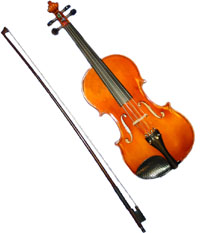Viola

The viola is slightly larger than the violin. Like the violin, sound is produced by the drawing the bow across one of the four strings or by plucking the string with a finger. All orchestra string instruments produce sound in the same manner. The main differences are the sizes of the instruments and how high or low each instrument can sound.
A small amount of maintenance and cleaning of violas is important. It is important to clean the instrument with a soft rag and occasionally change the strings. The most time consuming activity other than playing the instrument is tuning. The viola should be tuned every day or every time it is taken out of the case. In the beginning, teachers tune the string instruments for each student. Eventually, students will learn to tune their own instrument.
The viola comes in just two pieces, the instrument and the bow. The bow uses horsehair or a synthetic material to vibrate the strings as it is drawn over the strings. The bow should be tightened to just the right tension before it is used and loosened before it is put away.
The viola is played with the instrument under the chin on the left side. A shoulder pad is used under the viola and on top of the left shoulder. Teachers may encourage the use of a simple foam pad or a pad that attaches to the bottom of the viola. The right hand holds the bow at the bottom (the bottom of the bow is called the “Frog”) and draws the bow over the strings. The correct hand position for the both hands as well as posture and arm positions are critical at the beginning stages. Beginners should not practice extensively without guidance from a teacher. Developing bad habits in the beginning may be very difficult to break.
The viola is a very old instrument. It has been basically unchanged for hundreds of years. The viola looks and sounds a lot like a violin. The difference has to do with size and pitch. Both instruments have four strings. The highest violin string is the ‘E’ string. If you were to remove this highest string and add a new lowest string or ‘C’ string, you would have a viola.
A unique feature of student violas is the huge variation in sizes. Buyers have the option of a 15, 14, 13 or 12 inch viola. The correct size for each student depends on the arm length and overall size of the student. Generally speaking, by the time students reach 6th or 7th grade, most will require a full size or 15 inch viola. Before that age, students should be measured by a music teacher to determine the correct instrument.
The viola is not nearly as popular as the violin. Because there are fewer violists, orchestra teachers consider a good viola player as a very valuable asset to the group.
Violas are seen in symphony orchestra and occasionally in popular group string sections. In experienced hands the viola can perform beautful solo melodies as well as the more typical harmony parts with the violin.
There are lots of choices for purchasing a viola. Giardinelli sells a some good beginning models. If a full size viola is needed the “Strunal” model 3/90 FH viola outfit is beginning instrument. The next step up in all sizes is the Schiller 501 viola outfit. Purchasing a used viola can be a good option if it is purchased with caution. Older violas or violas that have not been well maintained can easily be in need of repair. A lack of humidity, temperature changes or just time can cause damage to the instrument. Small cracks in the wood develop which can be very costly to repair. Buying a used instrument is only recommended if you know an advance violist or orchestra teacher who can test a used instrument before you buy.